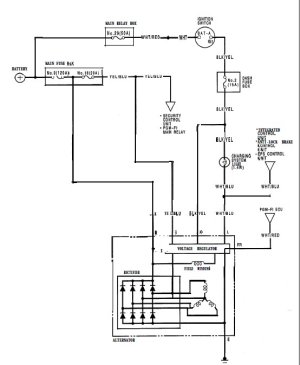Search on alternator and regulator turned up empty, with most complaints of low voltage. My car starts and drives fine, so I'm not sure there's a problem. All I could find was:
 www.nsxprime.com
Driving around & noticed that my volt gauge is reading ~15.0V (I know, hard to be sure with that gauge, but it pointed pretty much to the 15 notch.) I had never noticed that before, but I've only had the car a few months & I'm not sure I looked at it before. Seemed high compared to other Hondas I've had. I was wondering if the voltage is too high, or if the voltage is good but the NSX voltmeter is reading high. I assume too high voltage would damage something.
www.nsxprime.com
Driving around & noticed that my volt gauge is reading ~15.0V (I know, hard to be sure with that gauge, but it pointed pretty much to the 15 notch.) I had never noticed that before, but I've only had the car a few months & I'm not sure I looked at it before. Seemed high compared to other Hondas I've had. I was wondering if the voltage is too high, or if the voltage is good but the NSX voltmeter is reading high. I assume too high voltage would damage something.
NSX voltmeter compared to my Fluke multimeter:
Ignition on, but not running: NSX 12.8V, Fluke 12.2V
Ignition on, at idle: NSX 15.0V, Fluke 14.6V. Revved to 3k: no obvious change
So my NSX voltmeter seems to read ~0.5V high. If this is just the way it is, I can live with that. It's a blunt needle with only 90 degree sweep.
Alternator voltage?
Reading the service manual (23-101) is a flowchart for if the charging system light is on, but my charging system light comes on and then goes off as it's supposed to. The Regulator flowchart (23-103) seems to suggest that voltage up to 15.0 volts is fine, so I assume my 14.6 V measured with my Fluke means it's just a dash gauge that reads a wee bit high.
Anyone else notice that their voltmeter reads 15V when driving routinely?
Do I need a new alternator?
Yesterday, I had to jumpstart my 2000 before going out on a drive (the second time in a month, using the fusebox terminal). I usually warm/idle for 5 minutes but last night, proceeded going out of the neighborhood slow with my a/c on. After 3-4 miles on the backroad cruising at 55 mph, the...
NSX voltmeter compared to my Fluke multimeter:
Ignition on, but not running: NSX 12.8V, Fluke 12.2V
Ignition on, at idle: NSX 15.0V, Fluke 14.6V. Revved to 3k: no obvious change
So my NSX voltmeter seems to read ~0.5V high. If this is just the way it is, I can live with that. It's a blunt needle with only 90 degree sweep.
Alternator voltage?
Reading the service manual (23-101) is a flowchart for if the charging system light is on, but my charging system light comes on and then goes off as it's supposed to. The Regulator flowchart (23-103) seems to suggest that voltage up to 15.0 volts is fine, so I assume my 14.6 V measured with my Fluke means it's just a dash gauge that reads a wee bit high.
Anyone else notice that their voltmeter reads 15V when driving routinely?
Last edited:







